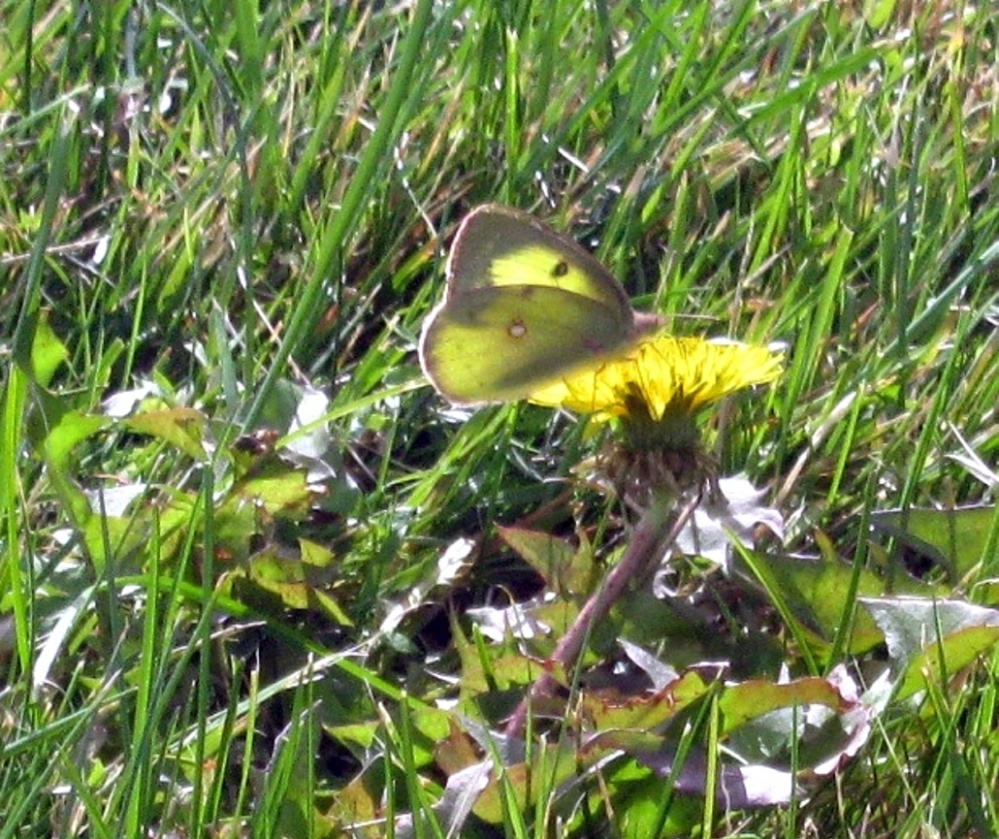Mid-September. The goldenrod and asters are glowing in the hazy afternoon sun. The maple leaves already show signs of dryness.
On this side of the chain-link fence around the basketball court, two yellow butterflies are chasing each other around like errant electrons. Dart and kiss, light, drop, skip along the grass and goldenrod. Hardly a breath of wind. Gauzy sunlight streams like gold over everything. The two clouded sulphurs flit and separate, one goes east, the other west toward the field. The east-moving wings swoop up then down, then back, and suddenly the chaotic yellow tandem pops together again, nips and flutters on beyond the cattails as if they were tethered on a string.
Are they mating? Or fighting? Or playing?
They don’t have the neural equipment to dance, do they? Or do they? Conventional depictions of cognitive capacity used to involve the physical size of a brain and the number of neurons in it. Neurons make up the biochemical circuitry of the mind. Each one is a treelike structure that moves sensory and other kinds of information around the nervous system. It receives information through its root, or dendrite, and sends it electrochemically up through its trunk, or axon, to twigs and branches that pass on the signals through synapses to other neurons.
Each of the human brain’s somewhere around 86 billion neurons makes up to tens of thousands of synaptic connections. Whale brains, it is roughly estimated, can have 200 billion neurons, African elephants 250 billion or more. Cats are said to have around 300 million neurons overall (though best estimates in our house are that our cat Panda has only a couple of dozen). An insect like a honeybee, or maybe a butterfly, has around a million neurons. Too few to have intelligence relatable to ours.
But some researchers are starting to think that brain size, and specifically the number of neurons, doesn’t exactly correlate to cognitive ability. Bees, it has been discovered, can learn to distinguish between images of human faces. Adult moths remember pain experienced as caterpillars. Individuals of some species of spiders show distinct personality types, including a kind of cobweb spider whose more aggressive females “participate more in colony defense and prey capture, while others are docile and engage more in brood care,” according to arachnologists Lena Grinsted and Jonathan Bacon. Butterflies — and all kinds of spiders and bugs, really — practice intricate mating behaviors involving odors we can’t smell, wavelengths of light we can’t see, and who knows what else that’s invisible to us.
What seems to drive behavior and — can we meaningfully put it this way? — awareness is not the number of neurons, but the way they process signals. “Flying insects,” says Jamie Theobald, who studies bees, “may have evolved structural and molecular adaptations to squeeze more processing into fewer neurons.” He notes the perennial computer analogy: The CPU in a very small computer like your phone is far more diversely powerful than the CPUs in room-size computers of a few decades ago because it processes zeroes and ones in different ways with less hardware. The same general idea may apply to insects and mammals. One million neurons in a bee’s brain may have different or even more ways of processing the same kinds of information 86 billion or so neurons in a human brain do. Or whales, or elephants, or butterflies.
The flits in butterflight are only partially wind-driven: Something in that tiny electrochemical processing unit makes decisions about where it’s going next that are not simply “instinct.” In one morph of their flight, male clouded sulphurs are defending territories. In another, they’re looking for females. And in another, making their pheromonic pitch to mate.
Do butterflies play? Do they dream about each other? Or about me, the way I seem to be dreaming of them on a hazy September day?
Somehow, this afternoon, these questions seem much larger, and stranger, and far more important than is dreamt of in our philosophy of neurons.
Dana Wilde lives in Troy. You can contact him at naturalist1@dwildepress.net. Backyard Naturalist appears the second and fourth Thursdays each month.
Send questions/comments to the editors.




Success. Please wait for the page to reload. If the page does not reload within 5 seconds, please refresh the page.
Enter your email and password to access comments.
Hi, to comment on stories you must . This profile is in addition to your subscription and website login.
Already have a commenting profile? .
Invalid username/password.
Please check your email to confirm and complete your registration.
Only subscribers are eligible to post comments. Please subscribe or login first for digital access. Here’s why.
Use the form below to reset your password. When you've submitted your account email, we will send an email with a reset code.